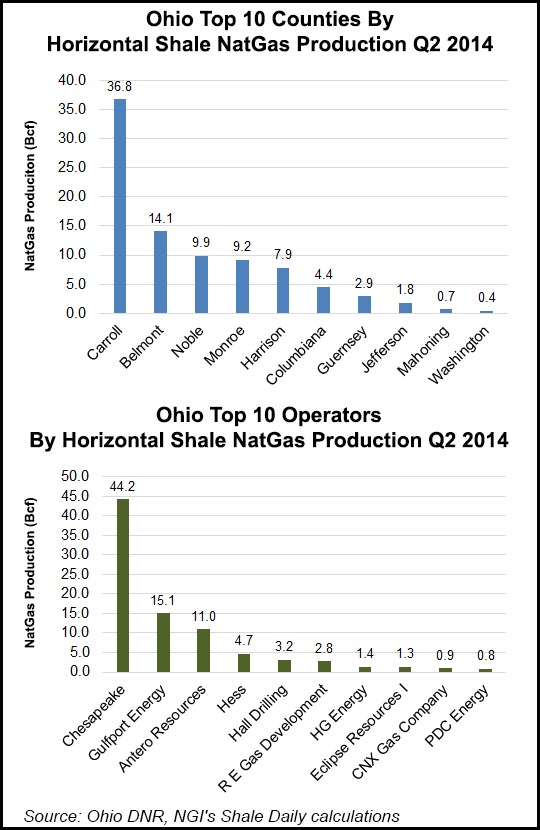Marcellus | E&P | NGI All News Access | NGI The Weekly Gas Market Report | Utica Shale
2Q2014 Ohio Unconventional NatGas Production Tops All of 2012
Continuing an upward climb, operators in Ohio’s Marcellus and Utica shales produced more than 88 Bcf of natural gas and 2.4 million bbl of oil last quarter, surpassing in three months what they churned out in all of 2012, state regulators said Monday.

That mark is no surprise, though. Since the Ohio Department of Natural Resources (ODNR) began reporting quarterly production last December as part of an amendment to the state’s biennial budget signed in June 2013 (see Shale Daily, Dec. 2, 2013), production has been steadily climbing.
It has risen above the 2012 benchmark, when unconventional commercial production started in earnest with just 85 wells reporting 12.84 Bcf of natural gas and 636,000 bbl of oil (see Shale Daily, May 17, 2013).
ODNR said 504 Marcellus and Utica wells reported production in the second quarter, up from 418 wells that produced 67 Bcf of natural gas and 1.9 million bbl of oil in 1Q2014 (see Shale Daily, July 2). Another 58 wells were awaiting pipeline connections, according to the agency’s report.
An overwhelming majority of the producing wells were in the Utica Shale, where operators have drilled 1,059 horizontal wells to date and permitted 1,474. That’s compared to just 44 permits that have been issued in the Marcellus Shale, where 27 horizontal wells have been drilled. Ohio law does not require the separate reporting of natural gas liquids, which are included in the report’s gas totals.
The average amount of oil produced last quarter was 4,895 bbl/d, while the average amount of gas produced was 175.9 MMcf/d over the course of 67 average producing days.
ODNR said the highest producing oil well was Antero Resources Corp.’s Myron well in Noble County, which produced 78,309 bbl in the second quarter. The highest producing natural gas well was privately-held Hall Drilling LLC’s Hercher North in Monroe County, which produced 1.4 Bcf.
Last year, combined unconventional and conventional natural gas production set a record in the state at 171 Bcf, driven mainly by high-volume horizontal fracturing (fracking) in the Utica Shale, which accounted almost entirely for 100 Bcf of that total (see Shale Daily, July 8). In July, when the annual production figures were released, Chief of ODNR’s Division of Oil and Gas Resources Management Richard Simmers said the state is “seeing a fairly significant increase in oil production.”
Unconventional oil production increased from 636,000 bbl of oil in 2012 to nearly 3.7 million bbl last year. During the same time, combined conventional and unconventional oil production went from 5 million bbl to 8 million bbl.
Also on Monday, the U.S. Energy Information Administration predicted that natural gas production in the Utica Shale would reach nearly 1.5 Bcf/d by October in its Drilling Productivity report. That’s up from a 1 Bcf/d estimate it released last month when it added the formation to the report because of the rapid growth in oil and gas volumes (see Shale Daily, Aug. 1).
© 2024 Natural Gas Intelligence. All rights reserved.
ISSN © 2577-9877 | ISSN © 1532-1266 | ISSN © 2158-8023 |
